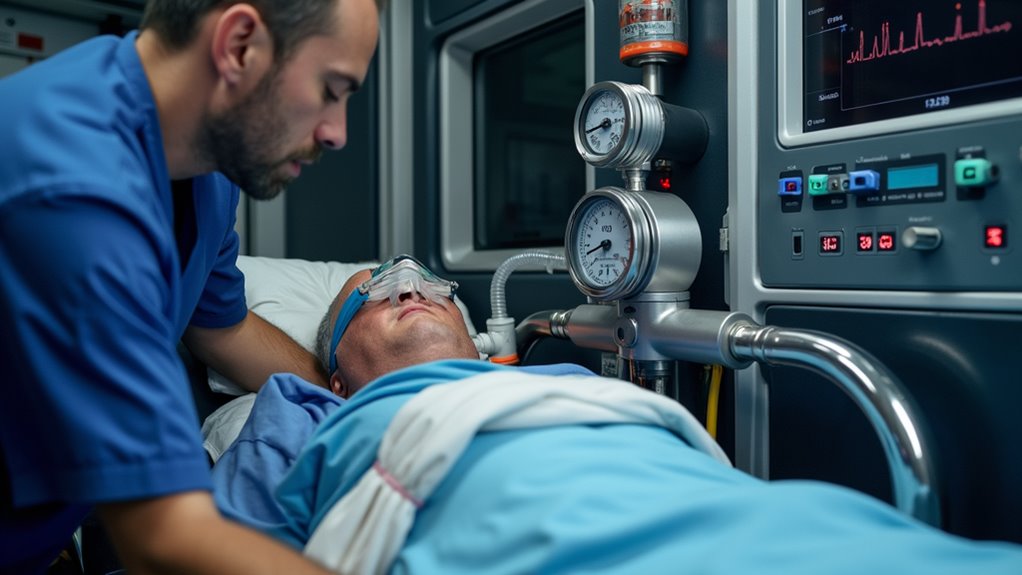Nitrous oxide provides rapid pain relief and conscious sedation in emergency medical settings. You’ll find it commonly used for fracture reductions, wound care, and minor surgical procedures, with patients remaining responsive throughout treatment. Medical teams deliver it through controlled systems at a 50:50 mix with oxygen while monitoring essential signs. It’s particularly effective in pediatric emergencies and pre-hospital transport, offering quick onset within 60 seconds and minimal recovery time. Further exploration reveals its extensive safety profile and clinical applications.
Common Applications in Emergency Departments

While nitrous oxide has broad medical applications, its use in emergency departments primarily centers on rapid pain management and procedural sedation. You’ll find it’s particularly effective for conscious sedation during fracture reductions, joint realignments, and wound care procedures. Patients remain fully responsive during treatment, allowing them to effectively communicate with medical staff throughout the procedure.
The minimal sedation effects dissipate within minutes of discontinuing treatment, allowing for safe and efficient patient discharge. Emergency analgesia with nitrous oxide proves invaluable for burn treatments, wound suturing, and minor surgical interventions.
In pediatric emergency settings, it’s especially useful for reducing anxiety and providing pain control during traumatic injury care. The gas mixture, typically administered as a 50:50 blend with oxygen, allows for quick onset of relief while maintaining patient consciousness. Since becoming popular in emergency departments in the late 1970s, this analgesic method has revolutionized acute pain management. Healthcare providers can easily titrate the dosage based on individual patient needs, making it an ideal choice for both adult and pediatric patients requiring immediate pain management in emergency situations.
Safety Guidelines and Patient Monitoring

Three fundamental safety protocols govern the medical use of nitrous oxide: proper patient selection, equipment safeguards, and continuous monitoring. Before any administration, you’ll need to verify that patients don’t have respiratory compromise, severe cardiac conditions, or key initial pregnancy.
Patient safety with nitrous oxide rests on three pillars: selecting appropriate candidates, maintaining equipment safeguards, and monitoring vital signs throughout treatment.
For safe nitrous oxide delivery, you must:
- Maintain scavenging systems to keep ambient gas levels below 25 ppm and perform regular equipment maintenance
- Monitor important signs continuously, including SpO2, respiratory rate, and blood pressure
- Use a titration-controlled delivery system with maximum 50:50 N2O:O2 ratio
- Observe patients for at least 15-30 minutes post-procedure to detect rebound hypoxia
Following the procedure, administer 100% oxygen for 5 minutes to effectively clear any remaining nitrous oxide from the patient’s system. Remember that NIOSH-approved respirators are required during maintenance procedures, and you’ll need immediate access to backup oxygen supplies for emergency scenarios.
Pediatric Benefits and Considerations

As an increasingly preferred option in pediatric care, nitrous oxide offers distinct advantages for managing children’s anxiety and pain during medical procedures. You’ll find it particularly effective due to its quick onset and prompt recovery, allowing children to resume normal activities almost immediately. Pediatric dental offices frequently utilize this sedation method to create positive experiences for young patients. The gas is delivered through a small nose mask that allows for precise control of the mixture.
| Benefits | Clinical Considerations |
|---|---|
| Quick onset | B12 deficiency risks |
| Prompt recovery | Folate metabolism concerns |
| Anxiety reduction | Genetic screening needs |
| Cost-effective | Short-term dizziness |
| Conscious sedation | Monitoring requirements |
While administering nitrous oxide, you’ll need to carefully consider metabolic factors. Children with B12 deficiency face increased risks of neurologic toxicity, and those with folate metabolism concerns require additional screening. The gas’s effectiveness in emergency procedures, from burn treatment to fracture reduction, makes it invaluable when you need rapid but controlled sedation.
Pre-Hospital Care and Transport Usage
Pre-hospital administration of nitrous oxide represents a significant advancement in emergency medical services (EMS), expanding pain management options beyond traditional opioids. You’ll find this intervention particularly effective during transport, with minimal dosage requirements and straightforward prehospital logistics. However, adequate ventilation must be maintained in the ambulance compartment to prevent unsafe gas accumulation. Some agencies opt to use nitrous oxide only in outdoor settings to minimize exposure risks for caregivers. The gas delivers rapid onset relief within 60 seconds of administration, making it ideal for acute pain management.
Nitrous oxide in EMS settings provides a crucial alternative to opioids, offering effective pain control with simpler logistics and precise dosing.
For successful implementation in emergency scenarios, consider these critical factors:
- The gas mixture must maintain a strict 50:50 nitrous oxide-oxygen ratio, administered via face mask under continuous pulse oximetry monitoring
- Patients must be alert and capable of self-administration, allowing them to control their pain relief
- Scene times should be short, making it ideal for rapid transport situations
- Implementation requires specific training and proper equipment, though the gas itself is cost-effective compared to traditional analgesics
The method offers rapid onset and elimination, proving especially valuable during brief emergency transports.
Clinical Studies and Treatment Outcomes
Clinical studies affirm nitrous oxide’s exceptional safety profile and treatment efficacy across diverse medical scenarios. You’ll find it demonstrates minimal respiratory effects and preserves spontaneous breathing, with rare serious events reported in controlled studies. Research shows a 16.5% rate of minor adverse events, primarily vomiting at 13.6%. With nurse-led sedation management representing 87.6% of cases, this demonstrates the procedure’s versatility across medical staff levels.
When combined with inhaled fluorinated anesthetics, it amplifies sedation success, though this may increase vomiting risk. The treatment proves particularly effective for pediatric procedures, including laceration repairs and minor surgeries in youthful individuals aged 2-6 years. You’ll notice shorter recovery times compared to traditional sedation methods, with high patient and parent satisfaction rates. Furthermore, it’s proven cost-effective, reducing emergency department stays and eliminating the need for extended post-procedure monitoring.
Frequently Asked Questions
How Long Does Nitrous Oxide Stay in a Patient’s System After Use?
You’ll experience rapid clearance of nitrous oxide from your system, with concentration levels dropping markedly within 5-10 minutes after stopping the gas.
Your recovery timeline is swiftly quick because the gas is primarily eliminated through exhalation, without storing in body tissues or requiring liver processing.
You’ll typically regain full mobility and mental clarity shortly after the procedure, making it possible to drive and resume normal activities soon afterward.
Can Pregnant Women Safely Receive Nitrous Oxide During Medical Emergencies?
Yes, you can safely receive nitrous oxide during pregnancy emergencies when administered in a controlled medical setting. Studies show minimal placental oxygen transfer concerns and negligible fetal cardiovascular effects when properly monitored.
You’ll need continuous essential sign observation during the initial 15 minutes, and you can’t combine it with sedatives or narcotics. While chronic exposure poses risks, short-term emergency use under medical supervision remains a secure option for pregnant patients.
What Alternatives Exist for Patients Allergic to Nitrous Oxide?
If you’re allergic to nitrous oxide, several alternative anesthetic agents are available for your care. Your healthcare provider can use methoxyflurane for short procedures, ketamine for deeper sedation, or local anesthetics for targeted pain control.
Patient allergy management protocols also include topical anesthetic options and non-pharmacological techniques. Your doctor will evaluate your medical history and procedure requirements to select the most appropriate alternative that safeguards your safety and well-being.
Does Nitrous Oxide Interact With Common Prescription Medications?
You’ll need to be cautious about dose interactions between nitrous oxide and several prescription medications. The most significant drug contraindications involve central nervous system depressants and narcotic pain relievers, which can dangerously increase sedation risks.
You should inform your healthcare provider about any medications you’re taking, especially methotrexate, as it’s known to have specific interactions. Alcohol and recreational substances must also be avoided when using nitrous oxide.
How Much Does Nitrous Oxide Treatment Typically Cost in Emergency Settings?
You’ll find that nitrous oxide costs in emergency settings vary based on several cost factors. Initial administration typically runs less than $10 per use, though you’ll need to account for equipment setup costs around $3,800 per unit.
Availability in hospitals affects pricing, with urban facilities often charging differently than rural ones. Your actual costs may fluctuate based on your location, provider type, and whether you’re receiving treatment via EMS or hospital emergency departments.

